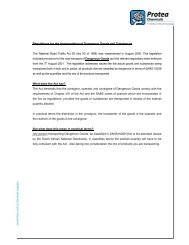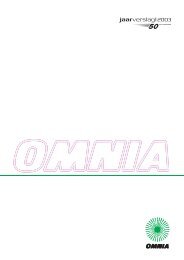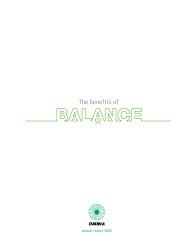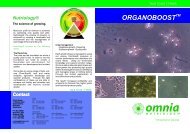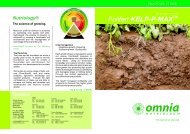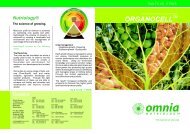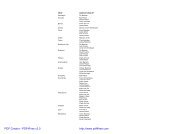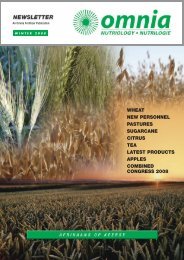omnia holdings annual report 2010 omnia holdings annu
omnia holdings annual report 2010 omnia holdings annu
omnia holdings annual report 2010 omnia holdings annu
You also want an ePaper? Increase the reach of your titles
YUMPU automatically turns print PDFs into web optimized ePapers that Google loves.
82 OMNIA ANNUAL REPORT <strong>2010</strong> FINANCIAL STATEMENTS continued<br />
NOTES TO THE GROUP FINANCIAL STATEMENTS continued<br />
for the year ended 31 March <strong>2010</strong><br />
recoverable and carried at cost less accumulated impairment<br />
losses. Impairment losses on goodwill are not reversed. Gains<br />
and losses on the disposal of an entity include the carrying<br />
amount of goodwill relating to the entity sold. Goodwill is<br />
allocated to cash-generating units for the purpose of impairment<br />
testing. The allocation is made to those cash-generating units or<br />
groups of cash-generating units that are expected to benefit<br />
from the business combination in which the goodwill arose.<br />
1.7.2 Other intangible assets<br />
An intangible asset is recognised when it is probable that the<br />
expected future economic benefits that are attributable to the<br />
asset will flow to the Group and the cost of the asset can be<br />
measured reliably. Separately acquired intangible assets are<br />
initially recognised at historical cost. Intangible assets acquired in<br />
a business combination are recognised at fair value at the<br />
acquisition date. Thereafter they are amortised using the<br />
straight-line method over the asset’s estimated useful life.<br />
Annually, the estimated remaining useful life is reviewed.<br />
Intangible assets are not re-valued. The estimated useful lives of<br />
intangible assets are as follows:<br />
� Trademarks and trade secrets 20 years<br />
� Patents 5 – 10 years<br />
� Distribution contracts 10 years<br />
� Software 5 – 10 years<br />
Costs associated with maintaining computer software<br />
programmes are recognised as an expense when incurred.<br />
Costs that are directly associated with the development of<br />
identifiable and unique software products controlled by the<br />
Group, and that will probably generate economic benefits<br />
exceeding costs beyond one year, are recognised as intangible<br />
assets when all of the following criteria are met:<br />
� it is technically feasible to complete the software product so<br />
that it will be available for use;<br />
� management intends to complete the software product and<br />
use it;<br />
� there is an ability to use or sell the software product;<br />
� it can be demonstrated how the software product will<br />
generate probable future economic benefits;<br />
� adequate technical, financial and other resources to<br />
complete the development to use or sell the software are<br />
available; and<br />
� the expenditure attributable to the software product during<br />
its development can be reliably measured.<br />
Costs include employee costs incurred as a result of developing<br />
software and an appropriate portion of relevant overheads. Other<br />
development expenditures that do not meet the criteria are<br />
recognised as an expense as incurred. Development costs<br />
previously recognised as an expense are not recognised as an<br />
asset in a subsequent period.<br />
Computer software development costs recognised as assets are<br />
amortised over their useful lives.<br />
1.7.3 Research and development<br />
Research expenditure is recognised as an expense when<br />
incurred. Costs incurred on development projects (relating to the<br />
design and testing of new or improved products) are recognised<br />
as intangible assets when it is probable that the project will be a<br />
success, considering its commercial and technological feasibility,<br />
and costs can be measured reliably.<br />
Other development expenses are recognised as an expense<br />
as incurred. Development costs previously recognised as an<br />
expense are not recognised as an asset in a subsequent period.<br />
Development costs that have a finite useful life and that have<br />
been capitalised are amortised from the commencement of the<br />
commercial production of the product on a straight-line basis<br />
over the period of its expected benefit.<br />
1.8 Financial assets<br />
(i) Classification<br />
The Group classifies its financial assets in the following<br />
categories: at fair value through profit or loss, loans and<br />
receivables, and available-for-sale. The classification depends on<br />
the purpose for which the financial assets were acquired.<br />
Management determines the classification of its financial assets<br />
on initial recognition.<br />
(a) Financial assets at fair value through profit or loss<br />
Financial assets at fair value through profit or loss are financial<br />
assets held for trading. A financial asset is classified in this<br />
category if acquired principally for the purpose of selling in the<br />
short-term. Derivatives are also categorised as held for trading<br />
unless they are designated as hedges.<br />
(b) Loans and receivables<br />
Loans and receivables are non-derivative financial assets with<br />
fixed or determinable payments that are not quoted in an active<br />
market. They are included in current assets, except for<br />
maturities greater than 12 months after the balance sheet date.<br />
These are classified as non-current assets. The Group’s loans<br />
and receivables comprise trade and other receivables and cash<br />
and cash equivalents in the balance sheet.<br />
(c) Available-for-sale financial assets<br />
Available-for-sale financial assets are non-derivatives that are<br />
either designated in this category or not classified in any of the<br />
other categories. They are included in non-current assets unless<br />
management intends to dispose of the investment within<br />
12 months of the balance sheet date.<br />
(ii) Recognition and measurement<br />
Regular purchases and sales of financial assets are recognised<br />
on the trade date – the date on which the Group commits to<br />
purchase or sell the asset. Investments are initially recognised at<br />
fair value plus transaction costs for all financial assets not carried<br />
at fair value through profit and loss. Financial assets carried at<br />
fair value through profit or loss are initially recognised at fair<br />
value, and transaction costs are expensed in the income<br />
statement. Financial assets are derecognised when the right to<br />
receive cash flows from the investments have expired or have<br />
been transferred and the Group has transferred substantially all<br />
the risks and rewards of ownership. Financial assets at fair value<br />
through profit or loss are subsequently carried at fair value.<br />
Loans and receivables are carried at amortised cost using the<br />
effective interest rate method.<br />
Gains or losses arising from changes in the fair value of<br />
“financial assets at fair value through profit or loss” category



